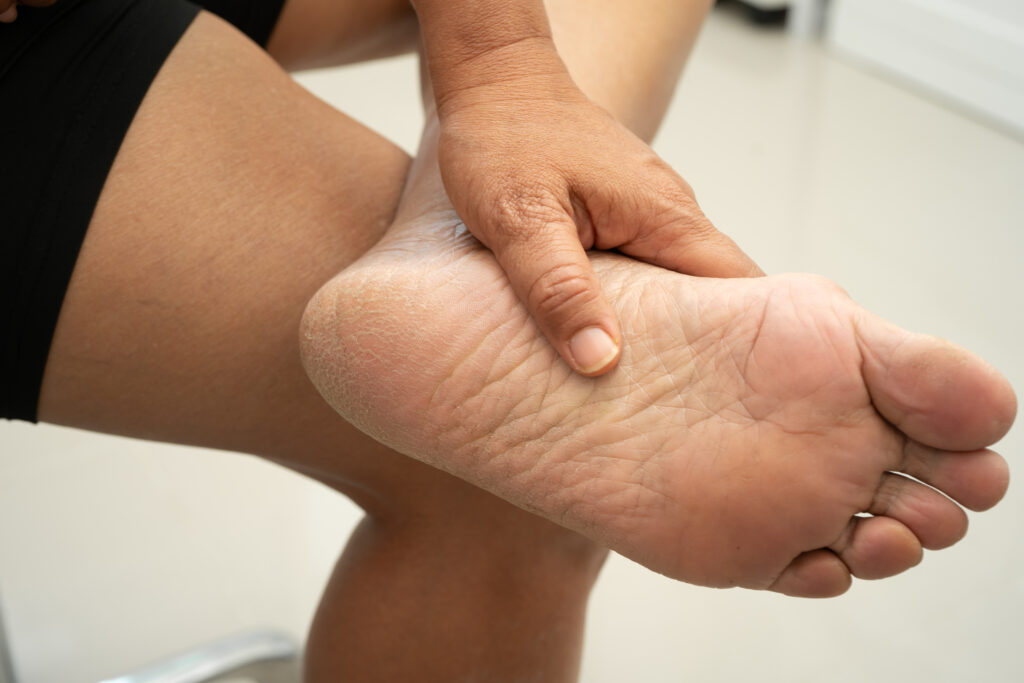s autumn arrives, it’s not just the cooler days and thicker clothing we need to prepare for — certain uncomfortable skin issues can also make an appearance. One of the most common is skin fungus, a type of infection caused by various fungal species that tends to develop more easily during the autumn months.
Closed shoes, warmer, less breathable clothing, increased sweating, and activities in communal areas (such as gyms and swimming pools) all create ideal conditions for fungal growth. Certain areas of skin, especially folds, may be more susceptible to infection. Skin fungus can develop and spread quickly in these areas.
Why is skin fungus more common in autumn?
Several factors favor the development of skin fungus in the fall months, which contribute to the spread of infection:
- Closed shoes and thick socks: feet sweat more easily, creating a moist, warm environment that provides the conditions for skin fungus to develop.
- Less ventilation: thicker clothing prevents the skin from drying and ventilating, which can also contribute to the development of fungal infections.
- Gyms, communal showers: in colder weather, more people go to indoor sports facilities, where the pathogen spreads mainly on areas of skin that come into contact with each other and can also cause flaky skin symptoms.
What are the most common symptoms?
- itching and burning sensation in the affected skin areas,
- red or whitish spots, peeling skin,
- rashes, which may even be blistered
- cracked, chapped skin between the toes or on the soles of the feet, and the nails may also be affected, becoming thickened, discolored, or brittle,
- unpleasant smell.
If symptoms are recognized early, treatment will bring relief more quickly.
How to prevent skin fungus?
- Keep your feet dry: always dry them thoroughly after bathing, exercising, or hiking, and use a separate towel.
- Choose breathable shoes and cotton socks: these help reduce sweating.
- Change your socks often: if they get sweaty, change them as soon as possible; this is important for prevention.
- Avoid walking barefoot in public places: always wear slippers in swimming pools and gym showers, as this also helps prevent infections.
- Use preventive powder or foot care products: these can help keep your skin dry and prevent the spread of fungi.
What should we do if we develop a fungal skin infection?
Once symptoms appear, it is important to act quickly. Pharmacies offer a variety of topical, over-the-counter preparations for treating skin fungus – these powders, ointments, and creams can help alleviate the symptoms. If the symptoms persist or the problem does not improve, you should definitely consult a doctor.
The doctor will decide on the appropriate treatment based on a thorough examination. In more serious cases, medication (e.g., tablets) may also be necessary.

What should we pay attention to during recovery?
When treating skin fungus, many people make the mistake of stopping treatment as soon as the symptoms – such as itching, flaking, or red spots – begin to subside. However, this is a serious mistake, as the fungal infection may still be present in the deeper layers of the skin and can easily return, even in a more severe form. Therefore, it is always advisable to continue treatment for the recommended period, even if the symptoms have disappeared.
The pathogens that cause fungal infections thrive in warm, moist environments, so it is particularly important to keep the infected skin areas dry and clean during the healing process. Avoid tight, poorly ventilated clothing and be careful not to use shared towels or clothing, as this can easily spread the infection to others.
It is important not to scratch or rub the infected skin area during treatment, as this can spread the infection and cause unpleasant symptoms to appear on other areas of the skin. Patience is key: treating skin fungus often takes a long time, and the healing process can vary from person to person. If the symptoms do not improve or appear on other areas of the skin, be sure to consult a doctor, who will help you choose the appropriate treatment depending on the severity of the infection and the type of fungus.
When preventing and treating skin fungus, the most important things are awareness, proper hygiene, and strict adherence to treatment instructions. This way, we can avoid recurring infections and get rid of unpleasant symptoms more quickly.
Don’t let skin fungus ruin your autumn!
Skin fungal infections do not discriminate – they can affect anyone, especially during the fall months when closed footwear, reduced ventilation, and frequent moisture provide an ideal environment for pathogens. Prevention is not complicated, but it does require awareness. Thorough hygiene, appropriate clothing, and recognizing the first signs of infection are key to avoiding more serious complaints.
The problem can be easily treated if detected in time, but if neglected, it can become a recurring problem and even cause complications. Don’t wait until the symptoms become overwhelming – pay attention to your body’s signals and, if necessary, seek advice from a pharmacist or dermatologist. With a little care and the use of the right products, we can ensure a healthy and comfortable autumn.
FAQ – Frequently Asked Questions
What causes skin fungus?
The unpleasant symptoms are caused by various pathogenic fungi, which multiply and spread rapidly, especially in warm, moist environments. These fungi can cause various symptoms, such as flaky, itchy, reddened areas of skin. Infection is particularly likely to occur if the immune system is weakened or hygiene conditions are inadequate.
How can skin fungus on the feet be prevented?
The most important thing is to keep your feet dry, wear cotton socks and breathable shoes, and wear slippers in shared showers.
What is the difference between foot fungus and nail fungus?
Foot fungus appears on the surface of the skin (e.g., between the toes, in the armpits, groin area), while nail fungus attacks the nail plate and is more difficult to treat.
When should you see a doctor about skin fungus?
If symptoms do not improve within a few weeks or continue to spread, it is definitely recommended to consult a dermatologist.
Sources:
A bőrgomba diagnosztizálása és kezelése – WEBBeteg
Bőrgomba: tünetei, kezelése és megelőzése | EgészségKalauz


